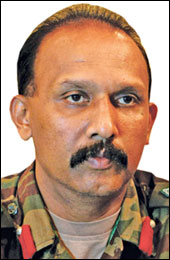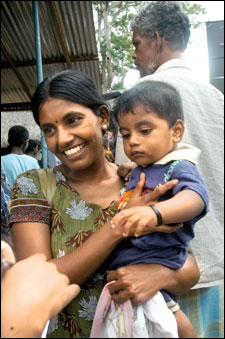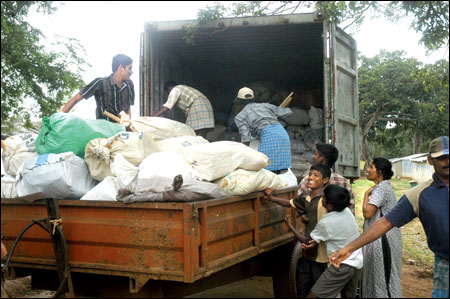Bold political decisions helped win war
Sandasen Marasinghe
Vanni Security Forces Commander and Competent Authority for IDPs
Major General Kamal Gunaratne said that it was a great achievement to
resettle more than 173,000 IDPs in their villages within five months
which was thought inconceivable by many people and national and
international organizations.
Addressing the media at the Vanni Security Forces Headquarters last
week, Major General Gunaratne said at the initial stage, the Government
had to receive over
|

Major General
Kamal Gunaratne |
282,000 IDPs from LTTE clutches in May and there were only 108,573
IDPs in relief villages as at December 23.
Thousands were resettled in their own villages on a daily basis
immediately after the area was cleared of mines, he said.
Major General Gunaratne said the victory of reducing the
well-motivated indoctrinated military organization with a strength of
more than 35,000 to an ideology was difficult. Of the LTTE cadres 23,000
were dead in the humanitarian operation and according to the records
12,258 were taken into custody.
The victory was so hard earned that 6,000 soldiers had to sacrifice
their lives while 27,000 were rendered disabled during the operation
against the LTTEs Eelam War 4. He said it was just a misunderstanding
that if some one claimed that it was just an easy task.
This historic achievement of the brave and valiant soldiers of Sri
Lanka was a result of nothing but a bold political decision to combat
them without any hesitation until the end not like the decisions by many
politicians in history to withdraw the Army at the threshold of victory.
The entire nation stood by the Forces on the battlefield including
villagers who invoked blessings by performing Bodhi Poojas.
There were a large number of Buddhist monks who joined the Forces in
support of this humanitarian operation.
Our politicians who entered into many ceasefire agreements with the
LTTE in the past were tricked by them on all occasions as those
agreements were breached by the LTTE. So this political decision topped
all the other reasons to win this war against the LTTE in 2009.
Major General Gunaratne further said that according to the UN
regulations the dangerous IDPs were separated from the other IDPs and
sent for rehabilitation. One of the challenges were to minimize the
civilian casualties which was successfully achieved by the Forces.
One of the biggest challenges were to receive more than 200,000 IDPs
during the humanitarian operation. “We never thought that we would have
to receive more than 100,000 IDPs within a short period of three days
amidst small arms fire, machine gun fire and mortar attacks,” he said.
|

A smiling mother with her child waiting to leave for their
native village of Pooneryn in Kilinochchi. Pictures by Sarath
Weerasinghe |
Major General Gunaratne said that it was really a challenge to
identify the LTTE cadres hiding among the civilians to cater to their
basic needs of shelter, health, transport, food and clothing. Most of
them had come with nothing other than the clothes they were wearing. The
Government took interest in them and the people from the South came
forward to support the IDPs by providing food, clothing, medicine etc.
without any hesitation.
Then with the support of the NGOs and INGOs the government
established the Manik Farm Relief Village and the Army had to muster
some battalions to cook meals for the IDPs. The Manik Farm was built
with three types of organizations. The first being the Relief Village
which consists of all facilities and the second being IDP Centres which
were established due to the congestion. They have fewer facilities and
were restored at Government buildings like schools. The third type was
the rehabilitation centres where the dangerous IDPs were attached.
Referring to the Relief Villages or the Transitional Relief Villages,
Major General Gunaratne stated that Kadirgamar Relief Village (Zone 0)
started with a initial strength of 217,726 and came down to 7,077 as at
December 23 and the Zone 1 or the Ananda Kumaraswamy Relief Village that
initiated with a strength of 43,824 was reduced to 20,647.
These two were established by the Government and were of the best
standard with all facilities and the one that were constructed by INGOs
were made of tinned sheets. He also said that the Ramanadan and
Arunachalam Relief Villages that were initiated with a strength of
69,513 and 41,175 have been reduced to 20,509 and 15,107 respectively.
The zones 4, 5, 6 that had an initial strength of 37,130, 8,192 and
6,349 were reduced to 11,772, 2,655 and 3,664 respectively. The
Dharmapuram, Weerapuram Relief Villages that had a strength of 10,550
was reduced to 3,509. In all the relief villages including those in the
Mannar District and Welioya IDP centre with its 349 IDPs there were
108,575. (By the time this edition went to press the Welioya IDP centre
had been closed and all IDP centres are closed).
The IDPs had to be kept in these centres restricting their freedom of
movement based on many reasons. The first being for their own security.
The LTTE had laid an incalculable number of mines, claymores and
explosives in their villages and there could have been stranded LTTEers
in the forests who would be a threat to the civilians. The Government
had to secure their safety before they were resettled. Certain groups
who sought to bring discredit to the government were complaining about
the delay of their resettlement. The second reason was to identify the
hidden LTTEers among the civilians. “We never wanted to spread the germ
of the LTTE again among the civilians bringing back disaster to them,”
Major General Gunaratne said.
|

Happy villagers in Pooneryn on a lorry full of goods provided
for them by the Government waiting to leave the Kadirgamar
Relief Village on December 23. Each family was provided cooking
utensils, equipment for farming, roofing sheets and Rs 50,000.
|
He said that the civilians extended great support to identify the
hidden LTTEers. They were battered enough by the LTTE. Even after five
months there are people who are pointing out the LTTEers to us. They
also provide us with information about hidden weapon hauls which are
still being unearthed today.
We also waited for the so-called Heroes Week of LTTEers to pass to
verify whether there was any threat by them. What we observed was no
blasts went off. When the intelligence units confirmed that there were
no signs of threat we informed the government of its long awaited piece
of information. Thereafter the Government opened all the relief centres
and IDP centres making them absolutely free.
“They have a temporary pass if they go out. We can’t call it a pass
but a piece of form to be filled for accountability,” Gunaratne said.
“We are responsible for the people who were with us.”
He said that to segregate the IDPs according to their birth places
was another challenge and time consuming process that delayed the
resettlement drive. It was really difficult as they were taken from one
place to the other by the LTTE for nearly 20 years. So that the GAs,
AGAs, GSs and many other government officials had their work cut out in
the last five months. They had to refer to electoral registers and many
other documents to identify the people in their villages and children
etc.
The officials with their prepared lists come and collect these
villagers from relief villages. “With the support of the Forces they
were transported to their native villages and when they identify their
lands they were assisted by the Forces to build their houses. Each
family was given cooking utensils, equipment for farming, roofing sheets
and Rs 50,000. Ninety families with its 324 members of the Zone 0 (Kadirgamar)
Relief Village whose original villages were in Pooneryn in Kilinochchi
were sent on Wednesday evening (December 23) for resettlement at
Pooneryn in 22 buses along with 11 lorries full of goods.
Army Spokesman Brigadier Udaya Nanayakkara and Major Dammika
Weerasekara also were present at the occasion. |



